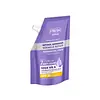What's inside
What's inside
 Key Ingredients
Key Ingredients

 Benefits
Benefits

 Concerns
Concerns

 Ingredients Side-by-side
Ingredients Side-by-side

Water
Skin ConditioningEthylhexyl Methoxycinnamate
UV AbsorberCetyl Alcohol
EmollientCyclopentasiloxane
EmollientGlycol Stearate
EmollientPropylene Glycol
HumectantSteareth-2
EmulsifyingSteareth-21
CleansingTriethanolamine
BufferingNiacinamide
SmoothingBenzophenone-3
UV AbsorberCaprylic/Capric Triglyceride
MaskingDimethicone
EmollientIsopropyl Myristate
EmollientSalicylic Acid
MaskingPhenoxyethanol
PreservativeParfum
MaskingTocopheryl Acetate
AntioxidantEthoxydiglycol
HumectantAcrylates/C10-30 Alkyl Acrylate Crosspolymer
Emulsion StabilisingPanthenol
Skin ConditioningPapain
Skin ConditioningEthylhexylglycerin
Skin ConditioningDisodium EDTA
Calcium Pantothenate
Maltodextrin
AbsorbentSodium Starch Octenylsuccinate
AbsorbentSodium Ascorbyl Phosphate
AntioxidantPyridoxine Hcl
Skin ConditioningSilica
AbrasiveWater, Ethylhexyl Methoxycinnamate, Cetyl Alcohol, Cyclopentasiloxane, Glycol Stearate, Propylene Glycol, Steareth-2, Steareth-21, Triethanolamine, Niacinamide, Benzophenone-3, Caprylic/Capric Triglyceride, Dimethicone, Isopropyl Myristate, Salicylic Acid, Phenoxyethanol, Parfum, Tocopheryl Acetate, Ethoxydiglycol, Acrylates/C10-30 Alkyl Acrylate Crosspolymer, Panthenol, Papain, Ethylhexylglycerin, Disodium EDTA, Calcium Pantothenate, Maltodextrin, Sodium Starch Octenylsuccinate, Sodium Ascorbyl Phosphate, Pyridoxine Hcl, Silica
Water
Skin ConditioningOctocrylene
UV AbsorberGlycerin
HumectantC12-15 Alkyl Benzoate
AntimicrobialMethylene Bis-Benzotriazolyl Tetramethylbutylphenol
UV FilterCaprylic/Capric Triglyceride
MaskingPolysorbate 20
EmulsifyingBis-Ethylhexyloxyphenol Methoxyphenyl Triazine
Skin ConditioningSodium Polyacryloyldimethyl Taurate
Emulsion StabilisingHydrogenated Polydecene
EmollientSqualane
EmollientButylene Glycol
HumectantEuterpe Oleracea Fruit Extract
Bisabolol
MaskingTocopheryl Acetate
AntioxidantHydrolyzed Collagen
EmollientEthylhexylglycerin
Skin ConditioningDecyl Glucoside
CleansingParfum
MaskingXanthan Gum
EmulsifyingCarbomer
Emulsion StabilisingAcrylates/C10-30 Alkyl Acrylate Crosspolymer
Emulsion StabilisingTrideceth-10
CleansingPalmitoyl Tetrapeptide-7
Skin ConditioningPalmitoyl Tripeptide-1
Skin ConditioningDipeptide Diaminobutyroyl Benzylamide Diacetate
Skin ConditioningCeramide NP
Skin ConditioningCeramide AP
Skin ConditioningCeramide EOP
Skin ConditioningChlorphenesin
AntimicrobialRetinol
Skin ConditioningPhytosphingosine
Skin ConditioningSodium Hyaluronate
HumectantCholesterol
EmollientSodium Lauroyl Lactylate
EmulsifyingPhenoxyethanol
PreservativeUbiquinone
AntioxidantHydroxypropyl Cyclodextrin
MaskingWater, Octocrylene, Glycerin, C12-15 Alkyl Benzoate, Methylene Bis-Benzotriazolyl Tetramethylbutylphenol, Caprylic/Capric Triglyceride, Polysorbate 20, Bis-Ethylhexyloxyphenol Methoxyphenyl Triazine, Sodium Polyacryloyldimethyl Taurate, Hydrogenated Polydecene, Squalane, Butylene Glycol, Euterpe Oleracea Fruit Extract, Bisabolol, Tocopheryl Acetate, Hydrolyzed Collagen, Ethylhexylglycerin, Decyl Glucoside, Parfum, Xanthan Gum, Carbomer, Acrylates/C10-30 Alkyl Acrylate Crosspolymer, Trideceth-10, Palmitoyl Tetrapeptide-7, Palmitoyl Tripeptide-1, Dipeptide Diaminobutyroyl Benzylamide Diacetate, Ceramide NP, Ceramide AP, Ceramide EOP, Chlorphenesin, Retinol, Phytosphingosine, Sodium Hyaluronate, Cholesterol, Sodium Lauroyl Lactylate, Phenoxyethanol, Ubiquinone, Hydroxypropyl Cyclodextrin
Ingredients Explained
These ingredients are found in both products.
Ingredients higher up in an ingredient list are typically present in a larger amount.
Acrylates/C10-30 Alkyl Acrylate Crosspolymer is a synthetic polymer. It is used to thicken and improve the texture of products. Due to its properties, it can prevent water and oil ingredients from separating.
This ingredient is an emollient, solvent, and texture enhancer. It is considered a skin-softener by helping the skin prevent moisture loss.
It helps thicken a product's formula and makes it easier to spread by dissolving clumping compounds.
Caprylic Triglyceride is made by combining glycerin with coconut oil, forming a clear liquid.
While there is an assumption Caprylic Triglyceride can clog pores due to it being derived from coconut oil, there is no research supporting this.
Learn more about Caprylic/Capric TriglycerideEthylhexylglycerin (we can't pronounce this either) is commonly used as a preservative and skin softener. It is derived from glyceryl.
You might see Ethylhexylglycerin often paired with other preservatives such as phenoxyethanol. Ethylhexylglycerin has been found to increase the effectiveness of these other preservatives.
Parfum is a catch-all term for an ingredient or more that is used to give a scent to products.
Also called "fragrance", this ingredient can be a blend of hundreds of chemicals or plant oils. This means every product with "fragrance" or "parfum" in the ingredients list is a different mixture.
For instance, Habanolide is a proprietary trade name for a specific aroma chemical. When used as a fragrance ingredient in cosmetics, most aroma chemicals fall under the broad labeling category of “FRAGRANCE” or “PARFUM” according to EU and US regulations.
The term 'parfum' or 'fragrance' is not regulated in many countries. In many cases, it is up to the brand to define this term.
For instance, many brands choose to label themselves as "fragrance-free" because they are not using synthetic fragrances. However, their products may still contain ingredients such as essential oils that are considered a fragrance by INCI standards.
One example is Calendula flower extract. Calendula is an essential oil that still imparts a scent or 'fragrance'.
Depending on the blend, the ingredients in the mixture can cause allergies and sensitivities on the skin. Some ingredients that are known EU allergens include linalool and citronellol.
Parfum can also be used to mask or cover an unpleasant scent.
The bottom line is: not all fragrances/parfum/ingredients are created equally. If you are worried about fragrances, we recommend taking a closer look at an ingredient. And of course, we always recommend speaking with a professional.
Learn more about ParfumPhenoxyethanol is a preservative that has germicide, antimicrobial, and aromatic properties. Studies show that phenoxyethanol can prevent microbial growth. By itself, it has a scent that is similar to that of a rose.
It's often used in formulations along with Caprylyl Glycol to preserve the shelf life of products.
Tocopheryl Acetate is AKA Vitamin E. It is an antioxidant and protects your skin from free radicals. Free radicals damage the skin by breaking down collagen.
One study found using Tocopheryl Acetate with Vitamin C decreased the number of sunburned cells.
Tocopheryl Acetate is commonly found in both skincare and dietary supplements.
Learn more about Tocopheryl AcetateWater. It's the most common cosmetic ingredient of all. You'll usually see it at the top of ingredient lists, meaning that it makes up the largest part of the product.
So why is it so popular? Water most often acts as a solvent - this means that it helps dissolve other ingredients into the formulation.
You'll also recognize water as that liquid we all need to stay alive. If you see this, drink a glass of water. Stay hydrated!
Learn more about Water